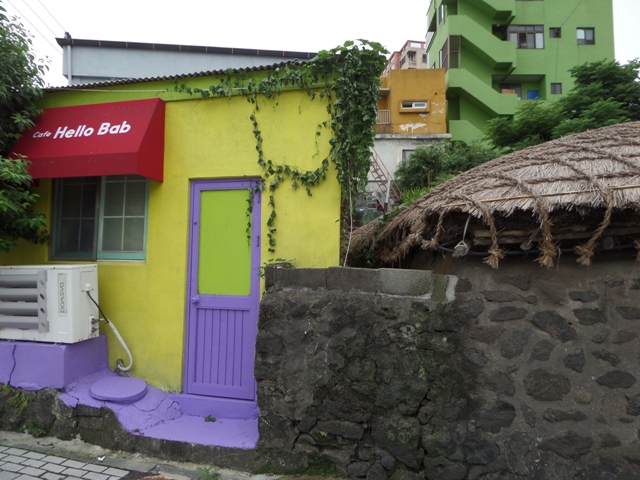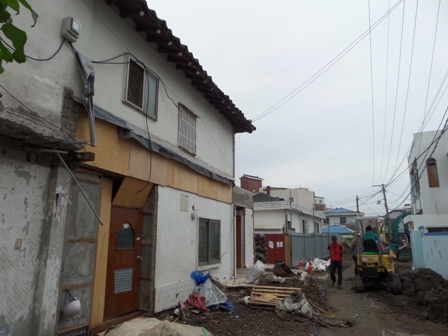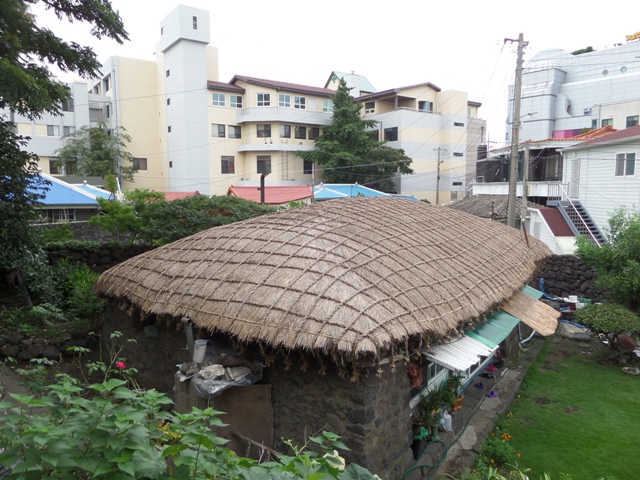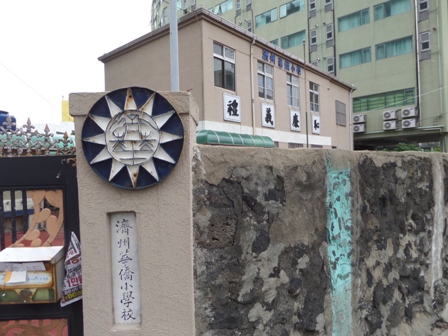| |
 |
|
| Clash of the new and old in Jeju's old town. Photo by Plamen Mavrov |
Jeju and its people have managed to weather more than typhoons over the last two centuries. Sitting in a geopolitically critical location on the north end of the East China Sea, it is dwarfed by great powers. Always in the service of one empire or another, Jeju has long suffered in the shadows cast by invaders and occupiers.
But, while Korea celebrated 70 years since its liberation from colonial rule, another shadow continues to expand over Jeju―globalization.
The rapid development of Jeju has threatened everything from its incomparable environment and waters to its food and history. History has taken a particular hit since it is seen as abstract and, therefore, dispensable.
However, a walking tour through the old district of Gu-Jeju with those at the vanguard of preservation efforts certainly shows history’s ubiquitous physical presence.
In mid-August, Ko Young-lim, chairwoman of the Jeju International Cultural Exchange Association (JICEA), and Tommy Tran, University of California-Los Angeles PhD candidate, led their second tandem walking tour of Jeju’s old district (and Ko's 14th overall), entitled “Jeju: In the Shadow of Empires,” aiming to once again raise awareness about Jeju’s endangered history.
After coming back in 2007 from 27 years abroad, Ko saw depopulation and neglect in Gu-Jeju’s historic coastal districts and began organizing and leading awareness-raising tours with her non-governmental organization, JICEA.
“Because of development of the new town, Shin-Jeju, the old town was suffering desertification [sic] in multiple ways. I wanted to make Jeju people discover the historical and cultural values of Jeju’s old town, because Jeju’s old town is the origin of Jeju history,” she said.
Asked how they go about picking the route, Tran said he looks at three main criteria: architectural distinctiveness, relevance to broader trends in Jeju history, and the importance to memory and lived experience.
| |
 |
|
| Parts of the old town are extremely rundown. Photo by Plamen Mavrov |
Guns, governors, and gods
For their last walk in May, they focused on the hidden history of the Tamna culture; the focus this time revolved around Jeju’s painful but important history under Japanese colonial rule from 1910 to 1945 and Jeju’s indirect exposure to Western imperialism.
“The colonial period is still fresh on Jeju people's minds even though it's already 70 years past liberation. Aside from political complications over war guilt and lingering resentment in Korea in general, in Jeju decolonization has yet to truly happen,” Tran said.
Starting from Gwandeokjong and Mokgwanaji, the site of many cultural and commercial activities at the time and the center of administration on the island, respectively, vestiges of Japan’s presence sit in plain sight.
The guides first pointed out a former ryokan (guesthouse) across from Jeju’s oldest elementary school (over 100 years old) and within a 5-minute walk from Gwandeokjong that was mainly occupied by Japanese. It sat in the city’s former upscale neighborhood.
As the last of its kind, the unassuming ryokan may soon face the bulldozer as construction work widening the road in front of it threatens to erase it.
Not far off lay Hyangsadang, a former Confucian archery forum and one-time academy. It was converted by the Japanese into a branch temple in 1916 and served only Japanese residents.
Even though the Japanese attempted to supplant Korean culture with their own, Tran noted the peculiar absence of encroachment onto Jeju’s religions up until the end of occupation.
“There was very limited interaction between Japanese religion and Jeju religion. Some elderly shamans on Jeju confirm that the Japanese colonial government did attempt to suppress Jeju shamanism with "anti-superstition" campaigns, but the oddity of the colonial social structure was that Korean and Japanese religion were kept separate. Until the end of the war period there was little will to assimilate Koreans fully into Japanese spirituality,” he explained.
Despite their oppressive rule, the Japanese helped bring modern inventions to the island, such as theater and cinema. Passing by the Jeju Hyeondae Theater, now an unnoticeable warehouse, one would never stop to consider that this theater employed professional silent film interpreters, or byeonsa, who, while disappearing from the mainland, maintained a presence on Jeju until the late 1970s.
Along with the Japanese presence, Western influence began to gain a foothold on the island. The rapid increase in the number of missionaries was made possible by the 1876 Treaty of Ganghwa that forced open Korea to the world. Catholicism had a tense relation with the locals. The construction of the Jungang Cathedral, one of the other stops on the tour, escalated such tensions until the locals erupted in rebellion in 1901, leading to a brief disruption in Catholic activities on the island.
Architecture as Identity
Such resistance by the Jeju people to hostile, outside influences was visible when the tour passed by a traditional thatched roof house, which, continuously inhabited for eight generations and 300 years, has survived dynastic threats, colonial rule, and commercial encroachment.
Something does need to be officially designated a heritage site to be of value and merit preservation and remembrance, Ko said.
“Even though this house isn't actually a tangible heritage, it is maybe the only traditional Jeju house in the old town. Places, houses, buildings are living memories. That's why I started the Jeju Old Town Exploring Program, to encourage people to preserve them, to keep our memories alive.”
| |
 |
|
| One of the few thatched cottages surviving in Jeju's old town. Photo by Plamen Mavrov |
Traditional houses such as the one we passed are rare and so are houses that successfully combined the aesthetic and functional merits of Korean and Japanese architecture.
Along the walk, Ko and Tran stopped at and described the history and hybrid style of two such endangered houses, the Yang family house and the Go family house, the latter previously threatened by the Arario Art Museum across the river from it.
Ko reflected on her efforts to stop an Arario takeover of the house and the uncertainty that still surrounds the house’s future.
“Arario Museum has a relationship with the Jeju Provincial Government. The Arario Museum can press the administration to use the Go house as their [second] gallery. Actually, the Go house is property of Jeju Province, and the government has a plan to repurpose the Go house, but I don’t know for what.”
The Go family house, for instance, is made of imported Japanese cypress and has shoji-style sliding doors. However, it possesses Korean-style floor heating and the same angeori-bakkgeori layout as Jeju indigenous houses.
Rebels and refugees
Jeju’s independent spirit has been strengthened over the decades by the continual arrival of refugees on its shores. Many hwagyo, or overseas Chinese, have been sheltered by the island since they first arrived on refugee boats almost a hundred years ago. Stopping by the Jeju Hwagyo School, walkers saw a prime example of hwagyo perseverance and the role Jeju has played for rebels and refugees alike.
| |
 |
|
| The old Chinese school. Photo by Plamen Mavrov |
The school was founded by several Chinese who fled Shandong region during the engulfing chaos in China in the 1930s following the Japanese invasion in 1931. It now serves as a Chinese-language hagwon and is the last remaining vestige of the hwagyo’s presence in the old city. It is staffed by but one teacher who has worked there for 30 years.
However, just like the composition of Chinese immigrants themselves, the locals' view of their presence has seen changes.
According to Tran, “On the one hand, people do distinguish between the Chinese immigrants of the earlier period (Hwagyo) and the current mainland tourists. Regarding Jeju people's attitudes, there is no doubt a growing wariness of the Chinese presence, but perceptions vary greatly. The greatest concern is that many of these newcomers, especially the nouveau riche, are simply here to treat Jeju as their playground and exploit it however way they wish.”
The future lies in the past
These were but some of the treasured sites in plain view but unbeknown to tourists and, sadly, many Jeju natives. Other sites included Chilseongtong commercial street and Sanjicheon harbor, and the Jeju Cheukhuso, or old meteorological center, now replaced by a modern one. Coupled with four memorable performances by Jeju Art Scenic along the way, the tour embodied the eclectic nature of Jeju.
Fellow walkers, Haebitchan Jung of the US and Shona Hamilton of Scotland, were thoroughly impressed and touched by the walk.
“Tommy’s counter-narrative for both the locals and foreigners to appreciate what the present and the past have to offer Jeju City is vital for the many historical sites and cultural artifacts increasingly viewed as unnecessary,” noted Jung.
Hamilton added, “'The excursion not only gave us an insight into Jeju City during the colonial period, but it enabled us to see the city in a different light. It is so easy to walk past buildings oblivious to the historical importance they may hold, but Tommy Tran's lecture inspired and enlightened me. We were not only connected with history but with current issues of what to do with sites from the recent past.”
It is uplifting to see people from all backgrounds, such as Tran and Ko, passionately working to save and protect the history of Jeju, and others, such as Jung and Hamilton, actively seeking to discover the Jeju behind the tourism slogans and brochures.
The harsh elements have forged a hearty culture for over fifteen hundred years, and it is not they that are in danger of sweeping it away. |























